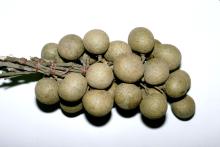Indices de Maturité
Longan fruit should be harvested ripe for best eating quality. They are harvested and marketed as clusters when the skin becomes smooth and its color changes to yellowish brown or light brown (depending on the cultivar). A minimum of 20% soluble solids may be used as a maturity index.
- Longan fruit vary in weight from 5 to 20g
- Smooth, thin, leathery, light-brown pericarp (skin)
- The aril (edible portion) is white surrounding a dark-brown or black seed
- Soluble solids content ranges from 18 to 22% and titratable acidity is low (pH = 6.2 to 6.7)
- Larger fruit that are free from defects (skin blemishes, insect damage) are preferred by consumers
Manipulation et stockage post-récolte
5 ± 1°C (41 ± 2°F); storage potential = 2-4 weeks, depending on cultivar
8-12 ml CO2/kg·hr at 10°C (50°F); 15-25 ml CO2/kg·hr at 20°C (68°F);non-climacteric respiratory pattern.
To calculate heat production multiply ml CO2/kg·hr by 440 to get Btu/ton/day or by 122 to get kcal/metric ton/day.
No published information.
90-95%. Maintaining high humidity and packaging to reduce water loss are very important in preventing skin color changes to dull, dark brown.
Less than 0.1 µl C2H4/kg·hr at 20°C (68°F)
Based on the limited published information, a CA combination of 3% O2 + 5% CO2 is effective in delaying skin browning and maintaining quality of longan fruit kept at 4°C for 35 days. Modified atmosphere packaging that results in 2-3% O2 and up to 5% CO2 is also effective in reducing water loss and associated darkening of the skin.
Désordres
Chilling injury. Symptoms include darkening of the skin color and increased susceptibility to decay. Also, some loss of flavor of the arils may occur.
Skin darkening. Skin changes from light brown to dark brown as a result of water stress (desiccation) of longan.
Decay-inducing fungi include Lasiodiplodia theobromae, Aspergillus niger, Cladosporium sp, and Fusarium sp. Decay control can be achieved by reducing physical injuries and proper management of temperature and relative humidity during postharvest handling. Sulfur dioxide treatment may be used in some countries to prevent skin darkening and control postharvest diseases of longan, but this treatment may result in undesirable taste and is not allowed on longan marketed in the U.S.A.



